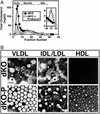Probucol prevents early coronary heart disease and death in the high-density lipoprotein receptor SR-BI/apolipoprotein E double knockout mouse
- PMID: 12771386
- PMCID: PMC165867
- DOI: 10.1073/pnas.1237725100
Probucol prevents early coronary heart disease and death in the high-density lipoprotein receptor SR-BI/apolipoprotein E double knockout mouse
Abstract
Mice with homozygous null mutations in the high-density lipoprotein receptor SR-BI (scavenger receptor class B, type I) and apolipoprotein E genes fed a low-fat diet exhibit a constellation of pathologies shared with human atherosclerotic coronary heart disease (CHD): hypercholesterolemia, occlusive coronary atherosclerosis, myocardial infarctions, cardiac dysfunction (heart enlargement, reduced systolic function and ejection fraction, and ECG abnormalities), and premature death (mean age 6 weeks). They also exhibit a block in RBC maturation and abnormally high plasma unesterified-to-total cholesterol ratio (0.8) with associated abnormal lipoprotein morphology (lamellar/vesicular and stacked discoidal particles reminiscent of those in lecithin/cholesterol acyltransferase deficiency and cholestasis). Treatment with the lipid-lowering, antiatherosclerosis, and antioxidation drug probucol extended life to as long as 60 weeks (mean 36 weeks), and at 5-6 weeks of age, virtually completely reversed the cardiac and most RBC pathologies and corrected the unesterified to total cholesterol ratio (0.3) and associated distinctive abnormal lipoprotein morphologies. Manipulation of the timing of administration and withdrawal of probucol could control the onset of death and suggested that critical pathological changes usually occurred in untreated double knockout mice between approximately 3 (weaning) and 5 weeks of age and that probucol delayed heart failure even after development of substantial CHD. The ability of probucol treatment to modulate pathophysiology in the double knockout mice enhances the potential of this murine system for analysis of the pathophysiology of CHD and preclinical testing of new approaches for the prevention and treatment of cardiovascular disease.
Figures





Similar articles
-
Loss of SR-BI expression leads to the early onset of occlusive atherosclerotic coronary artery disease, spontaneous myocardial infarctions, severe cardiac dysfunction, and premature death in apolipoprotein E-deficient mice.Circ Res. 2002 Feb 22;90(3):270-6. doi: 10.1161/hh0302.104462. Circ Res. 2002. PMID: 11861414
-
Diet-induced occlusive coronary atherosclerosis, myocardial infarction, cardiac dysfunction, and premature death in scavenger receptor class B type I-deficient, hypomorphic apolipoprotein ER61 mice.Circulation. 2005 Jun 28;111(25):3457-64. doi: 10.1161/CIRCULATIONAHA.104.523563. Epub 2005 Jun 20. Circulation. 2005. PMID: 15967843
-
Probucol enhances selective uptake of HDL-associated cholesteryl esters in vitro by a scavenger receptor B-I-dependent mechanism.Arterioscler Thromb Vasc Biol. 1999 May;19(5):1325-32. doi: 10.1161/01.atv.19.5.1325. Arterioscler Thromb Vasc Biol. 1999. PMID: 10323786
-
Scavenger receptor class B type I in high-density lipoprotein metabolism, atherosclerosis and heart disease: lessons from gene-targeted mice.Biochem Soc Trans. 2004 Feb;32(Pt 1):116-20. doi: 10.1042/bst0320116. Biochem Soc Trans. 2004. PMID: 14748727 Review.
-
Is there a genetic basis for resistance to atherosclerosis?Atherosclerosis. 2002 Jan;160(1):1-10. doi: 10.1016/s0021-9150(01)00664-5. Atherosclerosis. 2002. PMID: 11755917 Review.
Cited by
-
Probucol inhibits LPS-induced microglia activation and ameliorates brain ischemic injury in normal and hyperlipidemic mice.Acta Pharmacol Sin. 2016 Aug;37(8):1031-44. doi: 10.1038/aps.2016.51. Epub 2016 Jun 27. Acta Pharmacol Sin. 2016. PMID: 27345627 Free PMC article.
-
Extensive diet-induced atherosclerosis in scavenger receptor class B type 1-deficient mice is associated with substantial leukocytosis and elevated vascular cell adhesion molecule-1 expression in coronary artery endothelium.Front Physiol. 2023 Jan 12;13:1023397. doi: 10.3389/fphys.2022.1023397. eCollection 2022. Front Physiol. 2023. PMID: 36714321 Free PMC article.
-
Scavenger receptor BI modulates platelet reactivity and thrombosis in dyslipidemia.Blood. 2010 Sep 16;116(11):1932-41. doi: 10.1182/blood-2010-02-268508. Epub 2010 May 27. Blood. 2010. PMID: 20508162 Free PMC article.
-
Inhibition of intestinal absorption of cholesterol by ezetimibe or bile acids by SC-435 alters lipoprotein metabolism and extends the lifespan of SR-BI/apoE double knockout mice.Atherosclerosis. 2008 May;198(1):77-84. doi: 10.1016/j.atherosclerosis.2007.10.012. Epub 2007 Dec 3. Atherosclerosis. 2008. PMID: 18054357 Free PMC article.
-
Loss of PDZK1 causes coronary artery occlusion and myocardial infarction in Paigen diet-fed apolipoprotein E deficient mice.PLoS One. 2009 Dec 1;4(12):e8103. doi: 10.1371/journal.pone.0008103. PLoS One. 2009. PMID: 19956623 Free PMC article.
References
-
- Braun, A., Trigatti, B. L., Post, M. J., Sato, K., Simons, M., Edelberg, J. M., Rosenberg, R. D., Schrenzel, M. & Krieger, M. (2002) Circ. Res. 90, 270-276. - PubMed
-
- Krieger, M. (1999) Annu. Rev. Biochem. 68, 523-558. - PubMed
-
- Nakashima, Y., Plump, A. S., Raines, E. W., Breslow, J. L. & Ross, R. (1994) Arterioscler. Thromb. Vasc. Biol. 14, 133-140. - PubMed
-
- Reddick, R. L., Zhang, S. H. & Maeda, N. (1994) Arterioscler. Thromb. Vasc. Biol. 14, 141-147. - PubMed
Publication types
MeSH terms
Substances
Grants and funding
LinkOut - more resources
Full Text Sources
Other Literature Sources
Molecular Biology Databases
Research Materials

